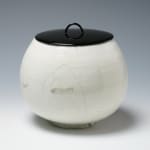KOBAYASHI Togo 小林東五
H17.7 × Dia 19.0 cm
Further images
-
(View a larger image of thumbnail 1
)

-
(View a larger image of thumbnail 2
)

-
(View a larger image of thumbnail 3
)

-
(View a larger image of thumbnail 4
)

-
(View a larger image of thumbnail 5
)

-
(View a larger image of thumbnail 6
)

-
(View a larger image of thumbnail 7
)

-
(View a larger image of thumbnail 8
)

-
(View a larger image of thumbnail 9
)

-
(View a larger image of thumbnail 10
)

The sensitive, scholarly and soulful potter Kobayashi Togo (b. 1935) creates works that are bound to the heart of the Mingei school in Japanese pottery. The movement in Mashiko was founded by Hamada Shoji and Yanagi Soetsu that observes that the work of the craftsman is the highest form of art. It is a movement that is deeply informed and inspired by historical inquiry into the heart of Japanese pottery, that speaks to the origins of Japanese potters’ taste and respect for functional wares that developed during the 17th century. Taste for vessels for daily use grew ubiquitous in Japan during this time. In the island of Tsushima near Nagasaki, where the clay is seen as equal to the quality and character of clay from the Korean Peninsula, Kobayashi Togo built his kiln in 1976.
Kobayashi (b. 1935) began his career by studying classical styles of Chinese calligraphy (in Japanese, Shodo 書道) and seal engraving with his late father, Kobayashi Zentei. His studies had eventually brought him to a deep fascination with Korean Goryeo ceramics and in 1973, he traveled to South Korea to study Joseon dynasty style ceramics. When he went back to Japan, he established his own kiln in Tsushima as an independent potter. He has been committed to the revival of Korean antique glaze types since the 1970s.
Korean style pottery, which presents tempered, asymmetrical forms that embrace imperfection, fit perfectly with Wabi sabi aesthetics. This quiet origin of pottery inspired Kobayashi, who has dedicated his life to creating robust works that are rich in history. Here is a potter based out of Tsushima, whose works are full of intelligence and meditation.









